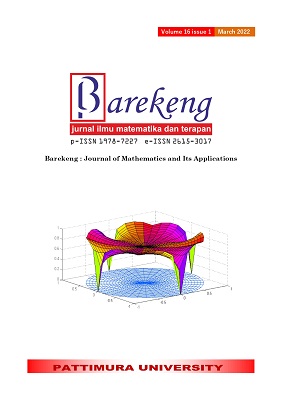DYNAMIC ANALYSIS OF THE MATHEMATICAL MODEL OF THE SPREAD OF CHOLERA WITH VACCINATION STRATEGIES
Abstract
This research discusses the math model of spreading cholera disease with a mathematical strategy of math model constructed by considering a vaccination strategy. In addition, there is a population of hyperinfectious and lessinfectious bacteria so that the model of SVIR-BhiBli type, by. The model formed in the form of determination of fixed point, determination of basic reproductions numbers, analyzing the equilibrium point and sensitivity analysis. The equilibrium analysis produces two equilibrium points of a immediate-free equilibrium point of aceletotic local if and endemic equilibrium points will be stable local asymptotics if . Furthermore, numerical simulation that the increase in vaccination rate influences on the decline in value while increased rate of vaccine depreciation can increase the value of . In addition, sensitivity analysis shows that if the parameter is enhanced while other contrast parameters will contribute to the increase in value, as a result can increase the rate of transmission of cholera disease. Whereas if the parameter is enhanced while other contrast parameters will contribute to the decrease in value, as a result of the dissemination of the disease can be pressed very significantly.
Downloads
References
D. S. Merrell et al., “Host-induced epidemic spread of the cholera bacterium,” Nature, vol. 417, no. 6889, pp. 642–645, Jun. 2002, doi: 10.1038/nature00778.
ECDC, “Measles. Annual epidemiological report for 2019,” Surveill. Rep., no. August 2012, p. 9, 2020.
WHOMedia centre, “Cholera.” [Online]. Available: https://www.who.int/en/news-room/fact-sheets/detail/cholera
A. Prayudi, “Perbandingan tingkat kewaspadaan serta faktor yang mempengaruhi pada sopir truk hauling shift siang dan malam kontraktor tambang batubara,” ["Comparison of the level of alertness and the factors that influence the day and night shift hauling truck drivers for coal mining contractors,"] Program Studi Kedokteran Kerja, 2010.
X. Tian, R. Xu, and J. Lin, “Mathematical analysis of a cholera infection model with vaccination strategy,” Appl. Math. Comput., vol. 361, pp. 517–535, Nov. 2019, doi: 10.1016/j.amc.2019.05.055.
E. Kokomo and Y. Emvudu, “Mathematical analysis and numerical simulation of an age-structured model of cholera with vaccination and demographic movements,” Nonlinear Anal. Real World Appl., vol. 45, pp. 142–156, Feb. 2019, doi: 10.1016/j.nonrwa.2018.06.011.
J. Lin, R. Xu, and X. Tian, “Transmission dynamics of cholera with hyper infectious and hypoinfectious vibrios: mathematical modelling and control strategies,” Math. Biosci. Eng., vol. 16, no. 5, pp. 4339–4358, 2019, doi: 10.3934/mbe.2019216.
A. R. Nuha and Resmawan, “Analisis Model Matematika Penyebaran Penyakit Kolera Dengan Mempertimbangkan Masa Inkubasi,” ["Analysis of the Mathematical Model of the Spread of Cholera by Considering the Incubation Period,"] J. Ilm. Mat. DAN Terap., vol. 17, no. 2, pp. 212–229, Nov. 2020, doi: 10.22487/2540766X.2020.v17.i2.15200.
N. Rahmi, “dinamika penyebaran penyakit kolera oleh bakteri Vibrio cholerae bertipe Hyper infectious,” ["The dynamics of the spread of cholera by Vibrio cholerae bacteria of the Hyper infectious type,"] IPB University, 2016.
R. J. Waldman, E. D. Mintz, and H. E. Papowitz, “The Cure for Cholera — Improving Access to Safe Water and Sanitation,” N. Engl. J. Med., vol. 368, no. 7, pp. 592–594, Feb. 2013, doi: 10.1056/NEJMp1214179.
P. van den Driessche and J. Watmough, “Reproduction numbers and sub-threshold endemic equilibria for compartmental models of disease transmission,” Math. Biosci., vol. 180, no. 1–2, pp. 29–48, Nov. 2002, doi: 10.1016/S0025-5564(02)00108-6.
R. Resmawan and N. Nurwan, “Konstruksi Bilangan Reproduksi Dasar pada Model Epidemik SEIRS-SEI Penyebaran Malaria dengan Vaksinasi dan Pengobatan,” ["Construction of Basic Reproductive Numbers in the SEIRS-SEI Epidemic Model of Malaria Spread by Vaccination and Treatment,"] J. Mat. Integr., vol. 13, no. 2, pp. 105–114, Sep. 2017, doi: 10.24198/jmi.v13.n2.12332.105-114.
C. Castillo-Chavez and B. Song, “Dynamical Models of Tuberculosis and Their Applications,” Math. Biosci. Eng., vol. 1, no. 2, pp. 361–404, 2004, doi: 10.3934/mbe.2004.1.361.
R. L. Miller Neilan, E. Schaefer, H. Gaff, K. R. Fister, and S. Lenhart, “Modeling Optimal Intervention Strategies for Cholera,” Bull. Math. Biol., vol. 72, no. 8, pp. 2004–2018, Nov. 2010, doi: 10.1007/s11538-010-9521-8.
C. Modnak, J. Wang, and Z. Mukandavire, “Simulating optimal vaccination times during cholera outbreaks,” Int. J. Biomath., vol. 07, no. 02, p. 1450014, Mar. 2014, doi: 10.1142/S1793524514500144.
C. T. Codeço, “Endemic and epidemic dynamics of cholera: the role of the aquatic reservoir,” BMC Infect. Dis., vol. 1, no. 1, p. 1, Dec. 2001, doi: 10.1186/1471-2334-1-1.
R. Resmawan, A. D. Wijayanti, L. Yahya, and A. R. Nuha, “Analisis Sensitivitas pada Model Matematika Transmisi Pengguna Narkoba dengan Faktor Edukasi,” ["Sensitivity Analysis on the Mathematical Model of Transmission of Drug Users with Educational Factors,"] J. Mat. Integr., vol. 16, no. 2, p. 95, Dec. 2020, doi: 10.24198/jmi.v16.n2.28804.95-103.
N. Chitnis, J. M. Hyman, and J. M. Cushing, “Determining Important Parameters in the Spread of Malaria Through the Sensitivity Analysis of a Mathematical Model,” Bull. Math. Biol., vol. 70, no. 5, pp. 1272–1296, Jul. 2008, doi: 10.1007/s11538-008-9299-0.
Authors who publish with this Journal agree to the following terms:
- Author retain copyright and grant the journal right of first publication with the work simultaneously licensed under a creative commons attribution license that allow others to share the work within an acknowledgement of the work’s authorship and initial publication of this journal.
- Authors are able to enter into separate, additional contractual arrangement for the non-exclusive distribution of the journal’s published version of the work (e.g. acknowledgement of its initial publication in this journal).
- Authors are permitted and encouraged to post their work online (e.g. in institutional repositories or on their websites) prior to and during the submission process, as it can lead to productive exchanges, as well as earlier and greater citation of published works.






1.gif)



